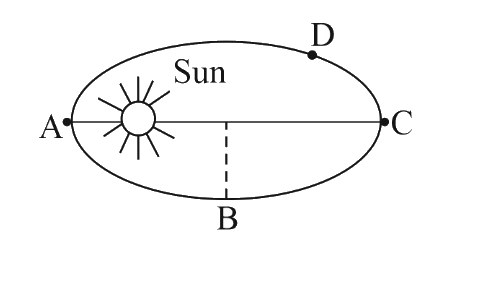When a planet moves around the sun
areal velocity is constant
linear velocity is constant
angular velocity is constant
All of the above
The correct Answer is:A
To solve the question regarding the motion of a planet around the sun, we need to analyze the concepts of aerial velocity, linear velocity, and angular velocity based on Kepler's laws of planetary motion.
1. Understanding Kepler's Second Law:
- Kepler's Second Law states that a line segment joining a planet and the sun sweeps out equal areas during equal intervals of time. This means that the aerial velocity (area swept out per unit time) of the planet is constant.
2. Defining Aerial Velocity:
- Aerial velocity can be defined mathematically as:
Aerial Velocity=dAdt
where dA is the area swept out and dt is the time interval. According to Kepler's Second Law, this remains constant.
3. Linear and Angular Velocity:
- Linear velocity refers to the speed of the planet along its orbital path, while angular velocity refers to the rate of change of the angle (in radians) that the planet sweeps out in its orbit.
- As the planet moves in an elliptical orbit, both the distance from the sun and the speed of the planet change. Therefore, linear velocity and angular velocity are not constant.
4. Conclusion:
- From the analysis, we conclude that:
- Aerial velocity is constant.
- Linear velocity and angular velocity are not constant and change as the planet orbits the sun.
- Therefore, the correct answer to the question is that aerial velocity is constant, while linear and angular velocities are variable.
Final Answer:
- The correct option is: Aerial velocity is constant.
- Kepler's Second Law states that a line segment joining a planet and the sun sweeps out equal areas during equal intervals of time. This means that the aerial velocity (area swept out per unit time) of the planet is constant.
- Aerial velocity can be defined mathematically as:
Aerial Velocity=dAdt
where dA is the area swept out and dt is the time interval. According to Kepler's Second Law, this remains constant.
- Linear velocity refers to the speed of the planet along its orbital path, while angular velocity refers to the rate of change of the angle (in radians) that the planet sweeps out in its orbit.
- As the planet moves in an elliptical orbit, both the distance from the sun and the speed of the planet change. Therefore, linear velocity and angular velocity are not constant.
- From the analysis, we conclude that:
- Aerial velocity is constant.
- Linear velocity and angular velocity are not constant and change as the planet orbits the sun.
- Therefore, the correct answer to the question is that aerial velocity is constant, while linear and angular velocities are variable.
- The correct option is: Aerial velocity is constant.
Topper's Solved these Questions
- GRAVITATIONBOOK - DC PANDEY ENGLISHCHAPTER - GRAVITATIONEXERCISE - Check Point 10.2
20 Videos
- GRAVITATIONBOOK - DC PANDEY ENGLISHCHAPTER - GRAVITATIONEXERCISE - Check Point 10.3
15 Videos
- GRAVITATIONBOOK - DC PANDEY ENGLISHCHAPTER - GRAVITATIONEXERCISE - Level 2 Subjective
14 Videos
- GENERAL PHYSICSBOOK - DC PANDEY ENGLISHCHAPTER - GENERAL PHYSICSEXERCISE - INTEGER_TYPE
2 Videos
- KINEMATICSBOOK - DC PANDEY ENGLISHCHAPTER - KINEMATICSEXERCISE - INTEGER_TYPE
10 Videos
Similar Questions
A planet moves around the sun. It is closest to sun to sun at a distance d1 and have velocity v1 At farthest distance d2 its speed will be
View SolutionSTATEMENT -1 : When a planet revolves around Sun in an elliptical orbit, the work done Sun's gravitational force on the planet remains zero for any value of displacement.
and
STATEMENT -2 : The mechanical energy of Sun planet system remains conserved throughout the motion of planet.
View Solution
Knowledge Check
Assertion : Electron revolves around a positvely charged nucleus like a planet revolves around the sun.
Reason : The force acting in both the cases is of same kind.AIf both assertion and reason are true and reason is the correct explanation of assertion.BIf both assertion and reason are true but reason is the correct explanation of assertion.CIf assertion is true but reason is falseDIf both assertion and reason are false.If a planet revolves around the sun in a circular orbit of radius a with a speed of revolution T, then (K being a positive constant
AT=Ka2/3BT=Ka3/2CT=Ka2DT=Ka3When a satellite moves around the earth, the quantity which remains constant is
Aangular veloctiyBkinetic energyCpotential energyDaerial velocity
Kepler's law starts that square of the time period of any planet moving around the sun in an elliptical orbit of semi-major axis (R) is directly proportional to
View SolutionA planet revolves around the sun in an elliptical . The linear speed of the planet will be maximum at

View SolutionSuppose there existed a planet that went around the sun twice as fast as the earth. What would by its orbital size?
View SolutionWhich of the following statements are correct about a planet rotating around the sun in an elleptical orbit
View SolutionLength of a year on a planet is the duration in which it completes one revolution around the sun. Assume path of the planet known as orbit to be circular with sun at the centre. The length T of a year of a planet orbiting around the sun in circular orbit depends on universal gravitational constant G, mass ms of the sun and radius r of the orbit. if T∝Gambsrc find value of a+b+2c.
View Solution
